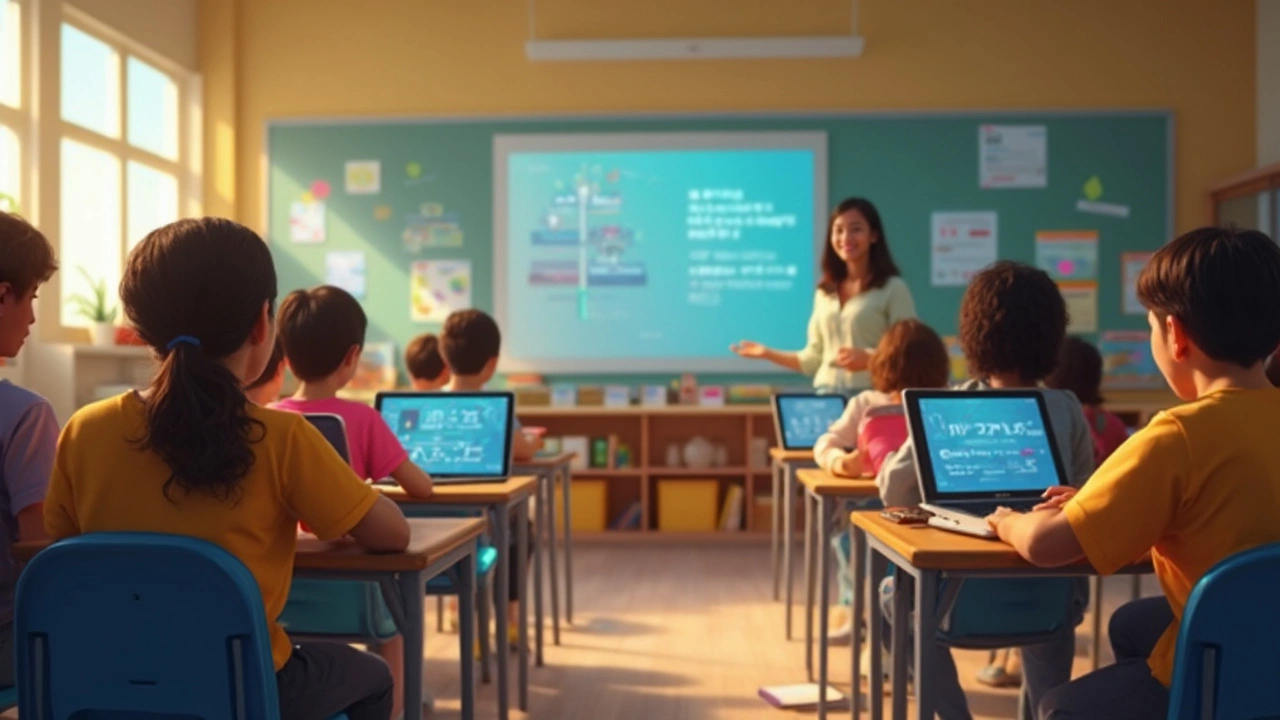As we wrap up another year, education remains a pivotal topic, with many grappling to choose between distance learning and traditional classroom settings. The educational landscape has evolved significantly, giving rise to diverse learning modes that cater to varying needs. It leaves students and educators alike pondering one key question: Which is the best option for learning?
In this ever-changing world, both distance learning and classroom education have their distinct draws. A few years ago, online learning was a niche, but now it's a prevailing force, reshaping how we perceive education. Meanwhile, the roots of traditional classrooms hold strong, cherished for their dynamic, interactive nature.
This article delves into the heart of both educational forms, scrutinizing their perks and hurdles. Our aim is to help you identify which approach aligns with your personal and academic goals, offering a guidance compass to steer your educational journey. Let's dive deeper into knowing what each method offers!
- Understanding Distance Learning
- Benefits of Online Education
- Classroom Learning Experience
- Comparison of Key Factors
- Tips for Choosing the Right Path
Understanding Distance Learning
Distance learning, often synonymous with online classes, has become more than a trendy alternative to traditional education; it's increasingly recognized as a mainstream method of delivering education across various disciplines. This mode of learning offers a unique combination of flexibility and accessibility that appeals to diverse learners worldwide. Students from different time zones, working professionals, parents juggling multiple responsibilities, and those with disabilities have found a learning haven in distance education. At the core, it leverages digital technologies, such as virtual classrooms and video conferencing, to replicate the instructional experience. The immersive nature of this learning form enables students to access course materials, attend lectures, and interact with peers and instructors, all from the comfort of their own chosen environment.
The beauty of distance learning lies in its ability to transcend physical boundaries, connecting learners with educators located at great distances. According to a 2023 report by Global Industry Analysts, the online education market is expected to reach a staggering $645 billion by 2030, reflecting the growing demand and recognition of its effectiveness. This trend is propelled not only by technological advancements but also by shifting societal values towards educational accessibility. The courses on offer range from business, technology, arts, to vocational skills, making it possible for anyone with an internet connection to pursue their dream qualification. The flexibility to study at your own pace suits self-motivated learners who appreciate autonomy and control over their educational decisions.
"The power of education is its ability to transform lives - and online learning increases the reach of that power by giving everyone the opportunity to grow and excel." - Educause Review
Despite its appealing attributes, distance learning also poses specific challenges. Maintaining self-discipline without the direct supervision of a physical classroom setting can be daunting for some students. Staying motivated calls for effective time management skills. Additionally, the lack of face-to-face interaction may lead some learners to feel isolated, potentially impacting their educational experience. However, many programs now incorporate interactive elements like group projects and discussion forums to foster a sense of community and collaboration among students. These virtual communities often serve as vital support networks, helping learners to share ideas, solve problems collectively, and form lasting relationships.
Benefits of Distance Learning
One significant advantage of distance education is its cost-effectiveness. By removing the need for physical infrastructure, transportation, and other associated costs, institutions can offer courses at a reduced price, making higher education more attainable for those on a tight budget. Additionally, online programs often provide asynchronous learning opportunities, allowing students to learn at times that fit best with their personal schedules and commitments. This kind of flexibility helps cater to different learning styles, enabling individuals to absorb information in a way that's most effective for them.
- Accessibility to varied courses and modules
- Opportunity to learn from renowned experts worldwide
- Customized learning pace
- Cost-effective education solutions
- Enhanced self-discipline and initiative
Distance learning also enables learners to cultivate digital skills essential for success in the modern workforce. As industries become more reliant on technology, the ability to navigate digital spaces—evident in completing assignments, participating in discussions, and collaborating online—becomes a valuable asset. This emphasizes the need for embracing these new methods of education, transforming traditional educational paradigms into more inclusive, progressive, and dynamic systems.
Benefits of Online Education
In an era where digital transformation touches every aspect of our lives, distance learning emerges as a pivotal educational choice. The shift towards online education has ushered in an array of benefits that extend beyond geographical boundaries. One of the most significant advantages of online learning is the flexibility it offers. Students are no longer tied to a strict schedule, enabling them to learn at their own pace. This flexibility is crucial for adult learners juggling multiple responsibilities such as work and family. With mobile technology at its peak, accessing course materials anywhere at any time is seamless, bridging the gap between education and convenience.
The accessibility of online classes means that students from different socioeconomic backgrounds can have equal opportunities for quality education. Various programs and courses are just a click away, and these options are often more affordable than their classroom counterparts. Another wonderful aspect is the diversity of programs available online. Whether you want to delve into computer science or engage in literary studies, there’s something for everyone. Students find that they can tailor their educational experiences to match their career aspirations, paving a clearer path towards achieving their goals.
Moreover, online education fosters self-motivation and time management skills. Without the direct oversight of a teacher in a physical space, students learn to manage their schedules and motivation levels independently. This autonomy helps build critical life skills that are invaluable in professional environments. Additionally, online classes often encourage active learning through discussion forums and interactive content, which can be more engaging than traditional lecture formats. Students collaborate globally, gaining insights from a broad spectrum of cultural perspectives, which enhances their global awareness.
A study conducted by the Babson Survey Research Group revealed that "over 30% of U.S. college students are now taking at least one course online," underscoring the growing acceptance and demand for online education.
Beyond personal benefits, there are institutional advantages too. Educational institutions seeking to expand their reach can do so with minimal physical infrastructure, reducing overhead costs and lowering tuition fees. This economic benefit is often passed on to the students, making higher education more affordable for many. Online learning platforms are also attractive for learners who seek diverse instructional methodologies. With video lectures, live sessions, downloadable resources, and interactive sessions, students can choose how they want to learn, customizing their education to their learning style.
Ultimately, the promising potential of online education cannot be understated. It offers unmatched opportunities for lifelong learning, enabling people at any stage of their lives to enrich their knowledge and skills. The integration of virtual reality and AI in online learning environments indicates that this educational mode will only grow and become more immersive. As the world continues to adopt digital-first strategies, online education will remain a significant part of shaping the future of learning, offering a versatile and inclusive platform for all learners.

Classroom Learning Experience
The traditional classroom education offers a unique and enriching learning environment that generations of students have experienced throughout their academic journeys. With direct interaction between teachers and students, it provides a structured setting that facilitates active participation and immediate feedback. This face-to-face engagement fosters communication skills and encourages the exchange of diverse ideas and perspectives. In a classroom, learners benefit from the presence of their peers, engaging group discussions, and collaborative projects that cultivate teamwork and critical thinking.
A distinctive feature of classroom education is the opportunity for hands-on learning. Whether it's conducting experiments in a science lab or partaking in a mock trial for a law class, these practical experiences are vital for certain fields. These interactions in a physical space contribute to a dynamic learning atmosphere where spontaneous questions and debates can arise naturally, enhancing the depth of understanding. Moreover, the presence of a teacher in the room provides immediate clarification and support, assisting students in tackling complex subjects.
The Importance of Routine
An often-underrated aspect of traditional learning is the routine it provides. Attending classes at set times promotes discipline and time management, skills essential not only in education but in professional life. The daily structure helps students establish a rhythm that can improve focus and retention of information. This consistency ensures that students remain engaged and keeps procrastination at bay, making it easier to meet academic deadlines. According to a report by the Canadian Education Association, students in traditional classroom settings tend to perform better in terms of organization and timely submission of assignments.
Classrooms also serve as a social hub where lifelong friendships and professional networks are often formed. Interacting with classmates in person enriches the learning experience by allowing students to share resources, provide mutual support, and motivate each other through challenges. The bonds formed in this environment build a sense of community and belonging, which significantly enhances the overall learning process. A quote from educational expert Professor John Hattie encapsulates this well:
"The connection with peers and teachers alike plays a crucial role in a student's cognitive and emotional development, offering a holistic approach to education that goes beyond textbooks."
Changing Dynamics in Modern Classrooms
Modern classrooms are adapting to incorporate technology, merging some features of distance learning with classroom education. Interactive whiteboards, digital textbooks, and online platforms for resources and assignments create a hybrid environment conducive to digital natives. This integration of technology not only enhances the learning experience but also prepares students for the technological demands of the contemporary workforce. Yet, despite these advancements, the physical presence in a classroom remains a cornerstone of the learning model, ensuring that traditional methods and new technologies blend seamlessly for an enriched learning journey.
Comparison of Key Factors
When evaluating distance learning against traditional classroom education, several key factors come to mind that significantly influence a student's choice. Chief among these is flexibility. In the realm of online classes, flexibility is unmatched. Students can access materials and complete assignments at times that best suit their schedules, a boon for those juggling work, family obligations, or other commitments. In contrast, classroom education typically requires a fixed schedule, which can be challenging for those needing greater time management autonomy. However, the structured routine of a classroom can benefit those who thrive on consistency; the need to physically attend classes can help instill discipline and provide a more organized framework for those who may struggle with self-pacing.
Another significant factor is interaction. The classroom experience often comes alive with dynamic interactions—face-to-face discussions, spontaneous debates, and direct engagement with educators and peers. These interactions can enhance understanding and help foster critical thinking skills. According to Harvard researchers, "In-person education facilitates a kind of spontaneous learning and networking that is less prevalent in online settings." Distance learning, while improving in offering interactive elements through video calls and discussion forums, may still feel isolating for some, lacking the immediate feedback and camaraderie found in a physical class environment. Nevertheless, virtual settings provide opportunities for international students to connect globally, potentially leading to a diverse learning community.
Cost-effectiveness is undeniably crucial, particularly as access to quality education continues to widen. Typically, online education is seen as a budget-friendly alternative. The absence of commuting expenses, accommodation costs, and in some cases, lesser tuition fees denote considerable savings. However, it's essential to acknowledge that investment in a reliable computer and internet connectivity is non-negotiable. Classroom education, on the other hand, may incur additional costs due to transportation, materials, and campus-related activities, yet might offer access to state-of-the-art facilities and resources in person that online platforms simply can't match.
The technological aspect also can't be overlooked. Distance learning stands at the forefront of utilizing technology to enhance educational experiences. Platforms offer various tools aimed at engaging students—interactive content, multimedia resources, and collaborative software. Yet, this advantage may come with a learning curve, especially for those less tech-savvy, potentially hampering the learning process. Classrooms, albeit tech-enhanced nowadays, focus more on direct human interaction and physical presence as the learning cornerstone. The option boils down to individuals' comfort level with technology and how well they can navigate it in pursuit of education.
Distance learning and classroom education both have distinct advantages that suit different learning styles and needs. By understanding these key factors—flexibility, interaction, cost-effectiveness, and technology engagement—students can better determine the educational path that aligns most closely with their personal and academic goals, leading to more effective and rewarding learning experiences.

Tips for Choosing the Right Path
Deciding between distance learning and classroom education can feel like standing at a crossroads, with each path leading to its unique destination. Understanding what lies ahead depends significantly on knowing yourself and your learning preferences. Start by assessing your personal learning style. Are you someone who thrives in a structured environment with face-to-face interaction and immediate feedback, or do you prefer the self-paced and flexible nature inherent to online classes? Recognizing your learning tendencies can greatly influence your decision, aiding in selecting the format that best promotes your success.
Another factor to consider is your personal and professional commitments, which undoubtedly dictate how much time you can devote to learning. Traditional classroom education often requires a fixed schedule, which might not be feasible if you have a demanding job or familial responsibilities. On the other hand, distance learning provides a certain level of freedom, enabling you to tailor your study hours around other obligations. It’s important to weigh these commitments carefully to ensure you can maintain a healthy balance between education and other life priorities.
Health considerations have also become increasingly relevant in today's world. Distance learning offers the advantage of studying in a safe environment without the concern of commuting or exposure to viruses and other health risks that might be prevalent in physical classrooms. However, on-campus learning can offer irreplaceable benefits, like enhanced social interaction and networking opportunities, which could be instrumental in many career paths.
"The best learning environments are those that align seamlessly with your lifestyle and educational goals," says Dr. Emily Harper, an education expert from the University of British Columbia.
Finally, you should consider the resource availability. Some fields of study may be better suited to a particular format; for example, highly technical or laboratory-based subjects might benefit more from the hands-on experience available in a traditional classroom setting. Conversely, subjects that rely heavily on theoretical knowledge or computer-based learning might lean naturally towards the virtual learning environment. Take note of the materials and access you will need, and weigh these needs against what each learning method offers.
In addition to these personal considerations, the technological aspect is paramount. Ensure you have the necessary technological infrastructure if you lean towards online classes. High-speed internet, a reliable computer, and a quiet learning space are crucial to your success. On the other hand, if technology is a barrier, the more personal interface of traditional learning might be more accessible. Thoughtfully considering these different elements can guide you to the right educational path.


